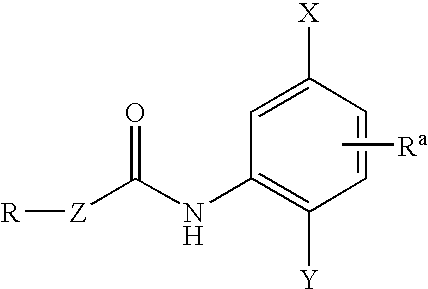Inhibitors of histone deacetylase
a technology of histone deacetylase and inhibitors, which is applied in the direction of chemical treatment enzyme inactivation, enzymology, drug compositions, etc., can solve the problems that the role of the other individual hdac enzymes has remained unclear, and achieve the effect of great therapeutic potential
- Summary
- Abstract
- Description
- Claims
- Application Information
AI Technical Summary
Benefits of technology
Problems solved by technology
Method used
Image
Examples
example 1a
(R)—N-(2-Amino-5-(thiophen-2-yl)phenyl)-4-((3-(dimethylamino)pyrrolidin-1-yl)methyl)benzamide (9)
[0724]
Step 1. tert-Butyl 4-bromo-2-nitrophenylcarbamate (2)
[0725]To a solution of 4-bromo-2-nitroaniline 1 (10.0 g; 46.1 mmol) and Boc-anhydride (20.11 g, 92.2 mmol) in THF (100 mL) stirred at room temperature was added a catalytic amount of 4-(dimethylamino)pyridine (DMAP). The reaction mixture was allowed to stir for 90 min, the solvent was removed in vacuo and the residue was dried under vacuum to produce colorless oil. The oil was dissolved in THF (46 mL), treated with an aqueous sodium hydroxide solution (2N, 46 mL) and heated to 65° C. for 18 h. Solid sodium hydroxide (1.8 g, 46.1 mmol) was added to the reaction mixture and heating was continued for 4 h; then the THF was removed in vacuo and a yellow solid crashed from the aqueous solution. The solid was filtered, washed with H2O and dried under vacuum to afford title compound 2 (15 g, >99% yield).
[0726]1H NMR (DMSO-d6) δ (ppm): 9....
example 2a
(E)-N-(2-Amino-5-(thiophen-2-yl)phenyl)-3-(6-(3,4-dimethoxyphenyl)pyridin-3-yl)acrylamide (42)
[0739]
Step 1: 5-Bromo-2-(3,4-dimethoxyphenyl)pyridine (37)
[0740]To a degassed solution of 2,5-dibromopyridine 35 (0.50 g, 2.11 mmol), 3,4-dimethoxyphenylboronic acid 36 (0.50 g, 2.74 mmol) and sodium carbonate (0.67 g, 6.3 mmol) in ethyleneglycol dimethylether (7 mL) and H2O (2 mL) was added tetrakis(triphenylphosphine)-palladium(0) (0.16 g, 0.14 mmol) and the solution was stirred at 75° C. for 18 h. The reaction mixture was filtered, concentrated, diluted with AcOEt, washed with brine, dried over MgSO4, filtered and concentrated. Flash chromatography of the residue (eluent: 3:1 hexane:AcOEt) provided title compound 37 (0.47 g, 76% yield).
[0741]1H NMR (DMSO-d6) δ (ppm): 8.70 (d, J=2.3 Hz, 1H), 8.04 (dd, J=8.6, 2.5 Hz, 1H), 7.91 (d, J=8.6 Hz, 1H), 7.65 to 7.61 (m, 2H), 7.04 (d, J=8.2 Hz, 1H), 3.83 (s, 3H), 3.80 (s, 3H).
Step 2: (E)-tert-Butyl 3-(6-(3,4-dimethoxyphenyl)pyridin-3-yl)acrylate (3...
example 3a
N-(2-amino-5-(thiophen-2-yl)phenyl)-6-chloronicotinamide (47)
PUM
 Login to View More
Login to View More Abstract
Description
Claims
Application Information
 Login to View More
Login to View More - R&D
- Intellectual Property
- Life Sciences
- Materials
- Tech Scout
- Unparalleled Data Quality
- Higher Quality Content
- 60% Fewer Hallucinations
Browse by: Latest US Patents, China's latest patents, Technical Efficacy Thesaurus, Application Domain, Technology Topic, Popular Technical Reports.
© 2025 PatSnap. All rights reserved.Legal|Privacy policy|Modern Slavery Act Transparency Statement|Sitemap|About US| Contact US: help@patsnap.com



